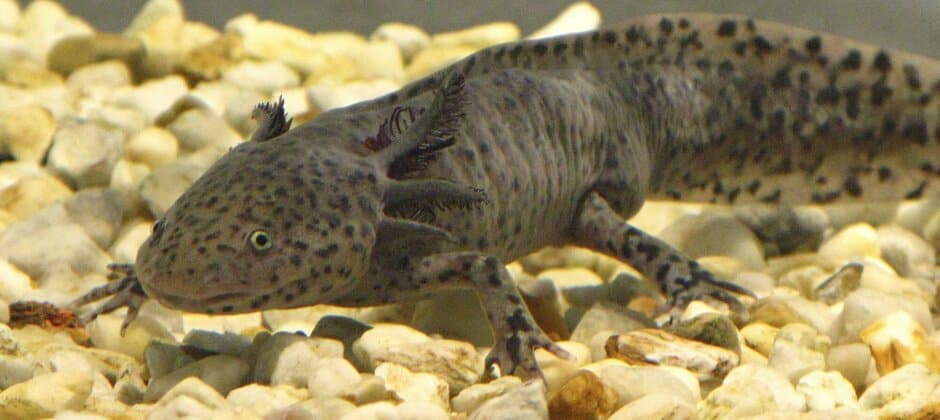Share this article
Creating refuges for axolotls in Mexico City
Luis Zambrano was used to surveying fish species in the Yucatan Peninsula before he got involved with studying axolotls.
The axolotl used to range more widely throughout Mexico City than it does today, when the area around the capital used to mostly be Lake Texcoco. But the Aztecs built their capital, Tenochtitlan, on an island in the lake, artificially expanding the island to make space for more development. After conquest, the Spanish continued this trend, and Mexico City is no longer an island. The remains of the original lake are known today as Xochimilco in the southern suburbs of the Mexican capital.
The shrinking of the aquatic area of the capital has resulted in an extensive loss in habitat for axolotls (Ambystoma mexicanum)—the salamanders are only found in Xochimilco and a few smaller waterbodies in the area. As Zambrano, a biology professor at the National Autonomous University of Mexico, began to survey the amphibians, he quickly realized the animals were depleting quickly.
“We discovered they were really in bad shape,” he said. “They were going toward extinction if we didn’t do anything.”
This was a problem ecologically—and culturally. The species, considered critically endangered by the International Union for Conservation of Nature, is named for the Aztec shape-shifting god Xolotl. The Aztecs also used to eat axolotls. “The axolotl is highly important for Mexicans because it’s part of our culture,” Zambrano said. In fact, the amphibians are featured on the new 50-peso bill.
Axolotls are related to tiger salamanders. Though adults are about the size of a banana, the salamanders are among the top predators in the lakes and canals where they are found, eating fish and invertebrates. They are also prey items for some aquatic snake species. Their regenerative abilities are also widely studied for their potential in medicine—there are likely many more captive axolotls in laboratories today than in the wild.
But “they have a lot of scientific properties that are highly important to study,” Zambrano said.

The canals around Xochimilco are an attraction for locals and tourists, but the water below is one of the last remaining refuges of axolotls. Credit: Joshua Rapp Learn
In Xochimilco, axolotls faced a number of problems. Carp and tilapia were introduced in the 1970s as a food source for residents. But carp will feed on axolotl eggs and tilapia prey on juvenile salamanders. Water treatment plants draining into Xochimilco also affected the water quality there, and unchecked development from one of the world’s largest cities has caused a number of other challenges for axolotls.
Zambrano and his colleagues had a feeling the best conservation solution would be to return the system to how it was historically—before these invasive fish were introduced and water quality was better. The Aztecs used to practice a type of agriculture using canal systems that favored axolotl habitat. Some farmers continue to mimic these traditional Indigenous methods in the Xochimilco suburbs, growing maize without using a lot of fertilizers or pesticides alongside canals.
In a study published recently in Aquatic Conservation, Zambrano determined that installing filters at the influx of water to these canals about 15 years ago has helped axolotls. The filters are fairly low-tech, but can help to reduce the phosphorous, nitrates and heavy metals that pass into these canals. Their research also showed that the infrastructure blocks the passage of carp and tilapia.
Zambrano and his colleagues surveyed two 200-meter canal passages, and found that the filters create sanctuaries for the salamanders. The areas inside the refuges had denser axolotl populations than they were before the filters were initially installed 15 years ago. Axolotls they reintroduced to these protected canals were laying eggs and breeding. Young axolotls were surviving for at least 12 months. Water quality also appeared to improve inside these refuges.
“The results from this study are encouraging as they suggest that two ponds have adequate conditions for axolotls to reproduce and for larvae and juveniles to survive,” the authors wrote in the study.
Zambrano said that restoring ideal habitat for these salamanders is key to keeping them in the wild—he further describes the methods in another recent paper in Ecological Restoration. But he also believes that the local people have to be invested in protecting the species for conservation to be successful.
His research shows that relying on traditional Indigenous agricultural techniques can work hand-in-hand with axolotl conservation. But the canals of Xochimilco aren’t all going to improve without more government support, he said, which could subsidize farmers using traditional practices. Increased demand for farm products grown using these techniques could also help, he said.
“You can’t try to restore the species without its habitat,” Zambrano said.
Header Image: Today more axolotls are estimated to live in captivity than in the wild. Credit: francis mckee








